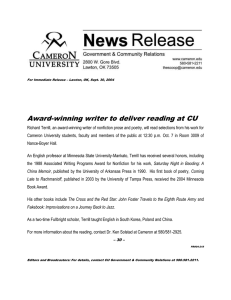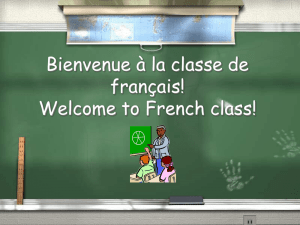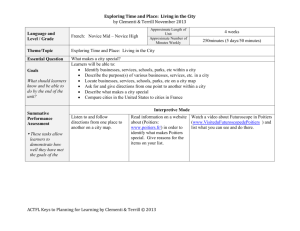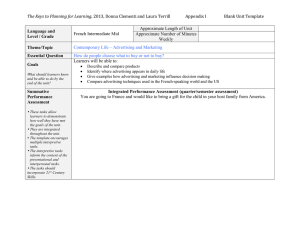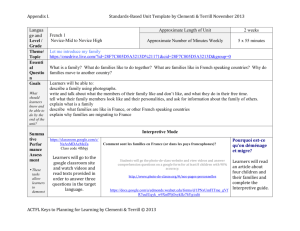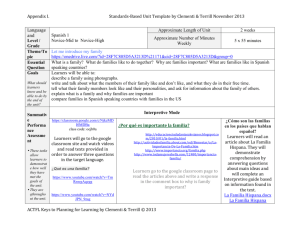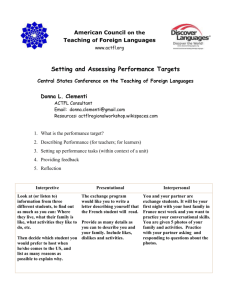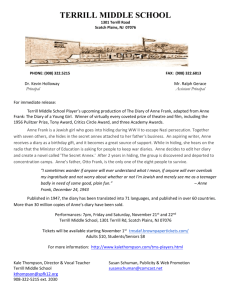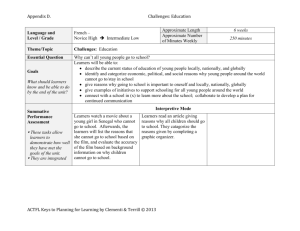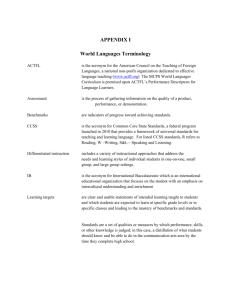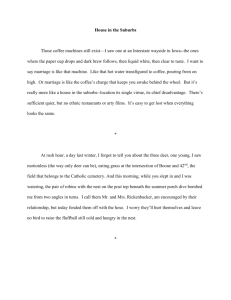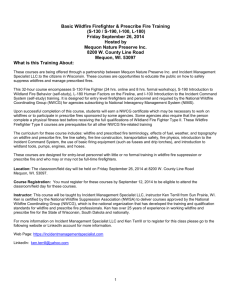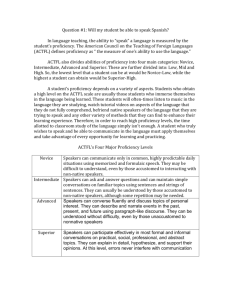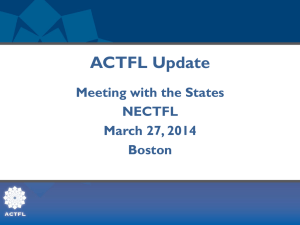Preliminary Unit - Learning a Language
advertisement
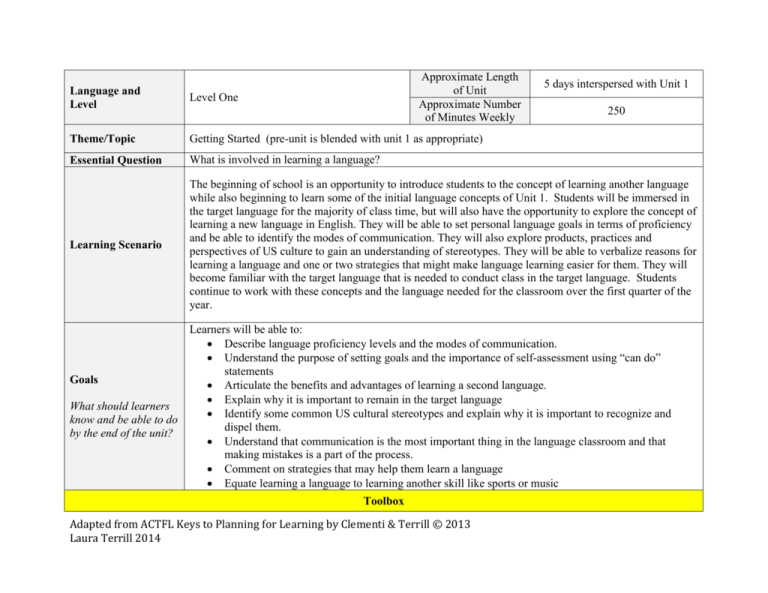
Approximate Length of Unit Approximate Number of Minutes Weekly 5 days interspersed with Unit 1 Language and Level Level One Theme/Topic Getting Started (pre-unit is blended with unit 1 as appropriate) Essential Question What is involved in learning a language? Learning Scenario The beginning of school is an opportunity to introduce students to the concept of learning another language while also beginning to learn some of the initial language concepts of Unit 1. Students will be immersed in the target language for the majority of class time, but will also have the opportunity to explore the concept of learning a new language in English. They will be able to set personal language goals in terms of proficiency and be able to identify the modes of communication. They will also explore products, practices and perspectives of US culture to gain an understanding of stereotypes. They will be able to verbalize reasons for learning a language and one or two strategies that might make language learning easier for them. They will become familiar with the target language that is needed to conduct class in the target language. Students continue to work with these concepts and the language needed for the classroom over the first quarter of the year. Goals What should learners know and be able to do by the end of the unit? 250 Learners will be able to: Describe language proficiency levels and the modes of communication. Understand the purpose of setting goals and the importance of self-assessment using “can do” statements Articulate the benefits and advantages of learning a second language. Explain why it is important to remain in the target language Identify some common US cultural stereotypes and explain why it is important to recognize and dispel them. Understand that communication is the most important thing in the language classroom and that making mistakes is a part of the process. Comment on strategies that may help them learn a language Equate learning a language to learning another skill like sports or music Toolbox Adapted from ACTFL Keys to Planning for Learning by Clementi & Terrill © 2013 Laura Terrill 2014 Language Functions Related Structures / Patterns name reasons for studying another language and culture (in English) state personal reasons for studying the target language (in English) identify a few strategies for learning languages (in English) explain how learning a foreign language compares to learning a sport or musical instrument (in English) recognize and use classroom expressions with visual support describe a product, practice and perspective of American culture name a stereotype of American culture and defend or refute it with evidence Priority Vocabulary Tier 1 common classroom expressions (as needed) common classroom objects (as needed) Tier 2 proficiency novice, intermediate, advanced modes of communication – interpretive, interpersonal, presentational Language Specific Responses Cultures (Sample Evidence) Indicate the relationship between the product, practice, and perspective. Product: McDonald’s Practice: love of fast food Perspective: everyone eats fast food, people don’t cook Product: Statue of Liberty Practice: celebrating freedom in US Perspective: we are a land of immigrants School and Global Communities Communities (Sample Evidence) Lifelong Learning Students begin to acquire key skills in learning a language. They understand the process of becoming bilingual. Key Learning Activities/Formative Assessments Key Learning Activity/Formative Assessment How does this activity Adapted from ACTFL Keys to Planning for Learning by Clementi & Terrill © 2013 Laura Terrill 2014 Mode of Interculturality (representative samples from beginning to end of unit) support the unit goals or performance tasks? Proficiency 1. Equate learning a language to a skill; show video or writing of individuals learning a language and ask students to think about how people show they are getting better in a language. Don’t provide answers. 2. Let students call out skills they are learning. Take a survey (polleverywhere) to determine the most popular skills in the class: music, sports, gardening, painting, writing, cooking. 3. Divide students into 5 or 6 groups depending on class size. Each group should be assigned one of the top skills. They are tasked with creating an image that shows improvement toward mastery of that skill. 4. Bring in use of target language in classroom. You learn a skill by doing it. Explain that is why class will be in target language. Teach process/language for expressing confusion, asking for help. 5. Bring in concept of making mistakes when trying to learn a new skill. Lead students to understand that mistakes are part of the learning process. 6. Show the NCSSFL-ACTFL Global Can Do Benchmarks and ask them for the similarities between what they have said and languages. 7. Explain that teachers must be Advanced Low (Int High) to be a certified teacher in the US. 8. Ask individuals to determine where they are at the present within each mode. Products, Practices, Perspectives 1. Ask students to work individually to generate a personal list of 10 items that are representative of American culture. Tell them they should only list those things that they are certain Adapted from ACTFL Keys to Planning for Learning by Clementi & Terrill © 2013 Laura Terrill 2014 Communication Self Community World everyone would think of as American. You might have to give an example by sharing a holiday like Thanksgiving. 2. Have students get into small groups to share their lists, looking for commonalities. 3. Brainstorm with the class to try to reach consensus on a top 10. 4. Ask why some of the ideas were rejected and use to discuss stereotypes. Make statements based on those that did not remain as part of the top 10. “All Americans eat barbecue.” Ask students to work in small groups to find evidence for or against the statement. 5. Take one of the class top 10 and use to explain product practice and perspective. Ask each group to illustrate one of the top 10. Reasons for Learning Languages 1. Encourage students to do a search for reasons to learn languages. Ask them to talk with other adults outside the school to see how languages play a role in their lives and careers. Invite them to send you infographics and articles that they find. 2. Allow students to brainstorm reasons for learning languages. 3. Have students post all the individual reasons around the room. Give each student 4 colored dots to vote for those that are most important to them. Repeat this process in other classes. Then, make a student poster capturing the most important student-generated reasons and display it. Classroom vocabulary and expressions 1. Show classroom scenes or school supply ads from target culture. Allow students to guess where the images are from before revealing the country. Have students locate countries on world map. Students can discuss in English and then for similarities and differences. Teach simple sentence pattern that can be used…..(In Mexico, they have…..we have….) Adapted from ACTFL Keys to Planning for Learning by Clementi & Terrill © 2013 Laura Terrill 2014 2. Have students act out various commands. Invite students to create illustrations of common expressions they will use on a daily basis. Classroom Rules and Procedures 1. Handout policies and ask students to read silently. Invite them to write questions as they read. Have students ask any questions that they may have. 2. Have students get in small groups and brainstorm positive statements that summarize the document. 3. Generate a class list and then narrow. Post these as the class rules. Resources Schools around the world: http://www.takepart.com/photos/classrooms-aroundworld/schools-around-the-world Technology Integration For quick surveys http://www.polleverywhere.com Celebrities speaking other languages: https://www.youtube.com/watch?v=y1YU0KOGHuQ http://www.businessinsider.com/celebrities-who-speak-morethan-one-language-2013-10?op=1 Culture Iceberg Lesson Plan http://www.afsusa.org/educators/teachers-toolbox/lessonplans/the-hidden-ways-in-which-cultures-differ/ Slideshare created by Jefferson County Public Schools http://www.slideshare.net/JCPSWorldLanguages/jcpsworld-language-classes-introduction-8829340 Sample Classroom Policy Adapted from ACTFL Keys to Planning for Learning by Clementi & Terrill © 2013 Laura Terrill 2014 Suggestions for Parent Nights Adapted from ACTFL Keys to Planning for Learning by Clementi & Terrill © 2013 Laura Terrill 2014
